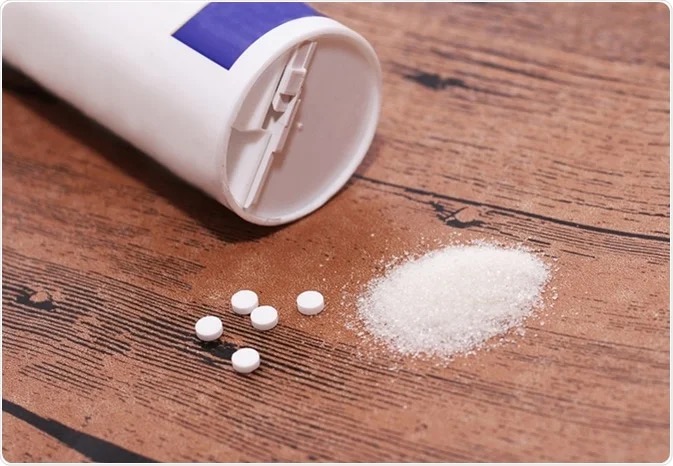Views: 222 Author: Sara Publish Time: 2025-10-24 Origin: Site








Content Menu
● Introduction to the nomenclature
● Chemical and systematic names
● Commercial brand names and market use
● Related and contextually connected sweeteners
● Why the naming matters for stakeholders
● Historical context and regulatory progression
● Data interpretation and scientific discourse
● Impact on food formulation and industry practices
● Global market dynamics and regional variations
● Safety communications and public health messaging
● Practical considerations for producers and formulators
● Visual and multimedia considerations in future editions
● A note on accuracy and ongoing research
● FAQ
>> 1. What is the most common brand name for aspartame?
>> 2. How is aspartame different from sucralose?
>> 3. Can people with phenylketonuria consume aspartame?
>> 4. Is aspartame naturally occurring or synthetic?
>> 5. Are there other sweeteners with similar names to aspartame?
Aspartame is a widely used artificial sweetener known for its high sweetness potency and very low caloric contribution. It is a dipeptide methyl ester composed of the amino acids phenylalanine and aspartic acid, giving it unique chemical properties that enable intense sweetness with minimal energy. Beyond its scientific name, aspartame is referred to by a range of synonyms, brand names, and related terms that appear across regulatory documents, product labels, scientific literature, and consumer-facing communications. Understanding these names helps stakeholders—from manufacturers to nutritionists to everyday shoppers—accurately identify aspartame in foods, beverages, and dietary supplements.

Aspartame's nomenclature spans several categories: the systematic chemical names, common and trivial names, brand names under which products containing aspartame are marketed, and closely related artificial sweeteners that are often discussed in parallel. Each category serves a distinct purpose: chemical names facilitate precise scientific communication, while brand names support consumer recognition and marketing. Regulatory documents may rely on the exact chemical descriptor to minimize ambiguity, whereas consumer labeling often uses familiar commercial names.
Aspartame exhibits several accepted chemical descriptors that reflect its structure and stereochemistry. In literature and regulatory files, you may encounter the following:
- L-Aspartyl-L-phenylalanine methyl ester
- Aspartylphenylalanine methyl ester
- Methyl aspartylphenylalanine
- 1-Methyl N-L-alpha-aspartyl-L-phenylalanate
These terms capture how the molecule is built from its constituent amino acids and the methyl ester linkage. They also convey key aspects about the molecule's chirality and functional groups, which can be important for analytical identification and regulatory assessment. Although these names can appear technical, they are essential for unambiguous scientific discussion and for cross-referencing in patents, safety dossiers, and toxicology studies.
In consumer products, aspartame is most commonly encountered under several widely recognized brand names. These brands have different historical origins and market strategies but refer to the same chemical compound. Typical examples include:
- NutraSweet
- Equal
- Canderel
- Aspartame Powder (as a generic or bulk form)
Branding helps manufacturers differentiate product lines, indicate formulation specifics (such as bulk ingredients or intended culinary use), and establish regional marketing presence. It is not uncommon for markets to favor one brand over another due to regulatory approvals, consumer familiarity, or co-branding arrangements with other ingredients.
Aspartame sits within a broader family of artificial sweeteners and sugar substitutes. In discussions of food formulation, regulatory science, and consumer choice, aspartame is often contrasted with or studied alongside:
- Saccharin
- Sucralose (often marketed as Splenda)
- Acesulfame potassium (Ace-K)
- Cyclamates
- Neotame
While these substances share the general purpose of providing sweetness with reduced or negligible caloric impact, they differ in chemical composition, metabolic fate, sensory profile, and regulatory status. Awareness of these distinctions helps formulators design blends that achieve desired sweetness levels, mouthfeel, and aftertaste characteristics while meeting safety and labeling requirements.

- For manufacturers: Correct naming ensures regulatory compliance, accurate labeling, and consistent quality control across ingredient suppliers, batch records, and finished products.
- For regulators: Precise chemical descriptors support risk assessment, labeling standards, and international harmonization of safety data.
- For consumers and healthcare professionals: Recognizable brand names and clear ingredient lists enable informed dietary choices, especially for populations with metabolic constraints such as phenylketonuria (PKU).
Aspartame's journey from discovery to global use is marked by scientific exploration, regulatory scrutiny, and public discourse. The compound was first synthesized in the 1960s and quickly attracted interest as a high-intensity sweetener with low caloric impact. The road to approval involved extensive safety testing, evaluation of potential health effects, and ongoing monitoring as new data emerged. Key phases include preclinical studies, initial petition submissions, and subsequent regulatory reviews by agencies worldwide.
- Early discovery and composition: The sweet-tasting properties were identified during routine chemical work, followed by investigations into the compound's stability, metabolism, and safety profile.
- Safety evaluations: Toxicology studies explored potential effects on reproduction, cancer risk, and neurophysiological outcomes. Regulatory bodies weighed the magnitude and reliability of data, considering variations in study design, adherence to good laboratory practices, and the replicability of findings.
- Regulatory approvals and expansions: After initial approvals, aspartame's allowed uses extended from dry goods to beverages and other products over time, influenced by evolving risk-benefit analyses and industry demand.
- Post-market surveillance: Ongoing monitoring, adverse event reporting, and periodic reviews contribute to maintaining safety assessments and updating labeling practices as needed.
The interpretation of aspartame safety has been the subject of intense scientific debate and public interest. Some criticisms focus on historical study methodologies, particularly regarding the timing and quality of some early toxicology studies. Proponents emphasize a broad evidence base from multiple independent studies and regulatory reviews that support a favorable safety profile when consumed within established acceptable daily intake (ADI) limits. Critics often advocate for continued vigilance and transparent data-sharing to address lingering questions about long-term effects and susceptible subpopulations.
Aspartame's properties influence not only taste profiles but also processing behavior in manufacturing environments. Its stability under heat and pH conditions can affect formulation decisions for baked goods, dairy products, and snacks. In high-temperature applications, manufacturers sometimes blend aspartame with other sweeteners to mitigate sweetness loss or aftertaste, tailoring the taste to regional preferences. Moreover, the low-calorie nature of aspartame makes it an attractive option for products targeting weight management, diabetes management, and general dietary reduction strategies.
Different regions may emphasize particular brand names, regulatory considerations, and consumer perceptions. For example, some markets historically relied on NutraSweet or Equal as the primary labeling cues, while others may use more generic ingredient lists that simply include “aspartame.” These variations can affect consumer recognition and purchasing decisions, making education about ingredient terms especially important for international travelers, expatriates, and multinational product developers.
Clear, evidence-based communication about aspartame helps mitigate misinformation and supports informed choices. Health authorities frequently publish summaries of safety reviews, including information about PKU considerations, safe intake levels, and comparative sweetness versus sugar. Transparent labeling and accessible educational materials empower consumers to make dietary decisions aligned with their health goals and cultural preferences.
- Ingredient sourcing: Ensure supply chain integrity by validating supplier certifications, lot-specific safety data, and compliance with applicable food safety standards.
- Labeling accuracy: Use approved nomenclature on ingredient lists, including any required disclosures related to PKU or phenylalanine content where relevant.
- Sensory optimization: Leverage blending strategies to balance sweetness intensity, aftertaste, and mouthfeel, potentially combining aspartame with other sweeteners or texturizers to achieve target product profiles.
- Regulatory compliance: Monitor updates from major food safety authorities to maintain alignment with permissible uses, labeling requirements, and regional variations.
In enhanced editions and future updates, embedding carefully selected visual aids such as molecular structures, flow diagrams illustrating digestion pathways, and comparative charts of artificial sweeteners can enrich comprehension. When incorporating multimedia, ensure that all assets are properly licensed, clearly labeled, and aligned with the article's factual content. While this edition focuses on text and structured sections, readers may benefit from well-curated visual supplements in accompanying digital formats or companion guides.
Scientific understanding of aspartame continues to evolve as new research emerges. Readers are encouraged to consult primary regulatory documents, recent peer-reviewed studies, and official health agency summaries to stay informed about the latest safety assessments, intake recommendations, and labeling standards. The synthesis of historical context, chemical understanding, and contemporary regulatory perspectives provides a comprehensive view of aspartame and its role in modern nutrition.
Aspartame, known by many other names including its chemical descriptors and brand names, remains a central component in the landscape of sugar substitutes. Its high sweetness potency, low caloric load, and wide acceptance in various food and beverage categories have solidified its status as a versatile ingredient for diet-conscious consumers and product developers alike. While concerns and debates persist in public discourse, the consolidated body of international regulatory evaluations generally supports its safety when consumed within established limits. Recognizing the array of names under which aspartame may appear—ranging from scientific terms to familiar brand names—equips manufacturers, researchers, and consumers to navigate product formulations, labeling, and dietary choices with greater confidence and clarity.

NutraSweet and Equal are among the most widely recognized brand names for aspartame-containing products.
Aspartame is a dipeptide-based sweetener containing phenylalanine and aspartic acid, while sucralose is a chlorinated derivative of sucrose with distinct metabolism and sensory properties.
No. Because aspartame contains phenylalanine, individuals with PKU must limit or avoid its intake and rely on alternative sweeteners.
Aspartame is synthetically produced and is not found naturally in foods in significant amounts; it is manufactured for use as a low-calorie sweetener.
Yes, several artificial sweeteners exist (such as saccharin, acesulfame potassium, and neotame), but they are distinct chemicals with different properties and regulatory statuses.
[1](https://en.wikipedia.org/wiki/Aspartame)
[2](https://www.fda.gov/food/food-additives-petitions/timeline-selected-fda-activities-and-significant-events-addressing-aspartame)
[3](https://dash.harvard.edu/bitstreams/7312037c-a990-6bd4-e053-0100007fdf3b/download)
[4](https://www.fda.gov/food/food-additives-petitions/aspartame-and-other-sweeteners-food)
[5](https://drinkperfy.com/blogs/all/a-brief-history-of-aspartame)
[6](https://en.wikipedia.org/wiki/Aspartame_controversy)
[7](https://aspartame.org/history-controversy/)
[8](https://dash.harvard.edu/bitstreams/7312037c-a98d-6bd4-e053-0100007fdf3b/download)
[9](https://pmc.ncbi.nlm.nih.gov/articles/PMC8497813/)
[10](https://theecologist.org/2005/aug/30/aspartame)
